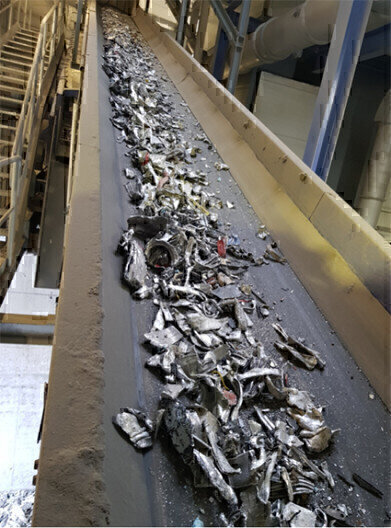-
 The profile rails leaving the Rotorshredder: not only shredded, but broken down too.
The profile rails leaving the Rotorshredder: not only shredded, but broken down too. -
 Pre-shredded profile rails as feed material next to the Rotorshredder (type RS 2018)
Pre-shredded profile rails as feed material next to the Rotorshredder (type RS 2018)
Waste management
Choosing the right shredding solution is important when recycling aluminum and aluminum scrap
Apr 16 2021
A waste management company located in southern Germany opted for the Rotorshredder (RS) from BHS-Sonthofen. This machine not only shreds the feed material, but also optimally breaks up composites, which results in fractions with a high degree of purity.
Aluminum scrap accumulates in many different forms, ranging from aluminum profile rails and Zorba fractions to shredder heavy fractions. A major challenge for recycling plants is contamination with other materials, in particular. For example, wood, plastic, and even other metals adhere to the sought-after aluminum. Which is why the materials need to be separated when processing these mixtures. For this reason, a waste management company based in southern Germany turned to BHS-Sonthofen at the end of 2019 in search of a new recycling solution for the 30,000 metric tons of non-ferrous metals that the company recycles annually.
The recycling of raw materials plays an increasingly important role,a recycling plant’s profitability hinges on high purity levels in particular. BHS-Sonthofen considers each application individually and chooses a shredding solution appropriate to the situation. “Impurities are a major problem when it comes to aluminum scrap,” explains Christian Kühn. “It’s not just about shredding the feed material, but it’s also about breaking down the materials in particular.” The Rotorshredder uses selective shredding to do so; aluminum is ductile, impurities such as plastic are hard and brittle. Impact forces deform the aluminum, causing the impurities to break down. In the process, the composites are efficiently separated from the feed material. After classification takes place, the high-purity aluminum is ready for sale. “It is to our advantage to have our own test center where we can carry out tests on the entire recycling process with the respective feed material, including the subsequent profitability calculation,” explains Kühn. “We can provide the customer with the exact machine or plant that is suitable for their requirements.”
Events
Jun 17 2025 Guangzhou, China
Singapore International Water Week Spotlight 2025
Jun 23 2025 Singapore
Jun 25 2025 Sao Paulo, Brasil
Jul 02 2025 Bangkok, Thailand
Jul 02 2025 Bangkok, Thailand















